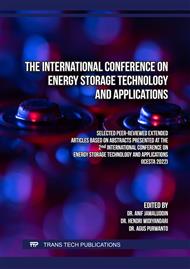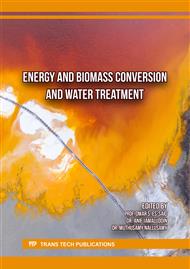[1]
P. F. Ribeiro, B. K. Johnson, M. L. Crow, A. Arsoy, and Y. Liu, "Energy storage systems for advanced power applications," Proc. IEEE, vol. 89, no. 12, p.1744–1756, 2001.
DOI: 10.1109/5.975900
Google Scholar
[2]
A. M. Divakaran et al., "Rational design on materials for developing next generation lithium-ion secondary battery," Prog. Solid State Chem., vol. 62, p.100298, 2021.
DOI: 10.1016/j.progsolidstchem.2020.100298
Google Scholar
[3]
Q.-Y. Wu, H.-Q. Liang, L. Gu, Y. Yu, Y.-Q. Huang, and Z.-K. Xu, "PVDF/PAN blend separators via thermally induced phase separation for lithium ion batteries," Polymer (Guildf)., vol. 107, p.54–60, 2016.
DOI: 10.1016/j.polymer.2016.11.008
Google Scholar
[4]
W. Chen, X. Wang, J. Liang, Y. Chen, W. Ma, and S. Zhang, "A High Performance Polyacrylonitrile Composite Separator with Cellulose Acetate and Nano-Hydroxyapatite for Lithium-Ion Batteries," Membranes (Basel)., vol. 12, no. 2, p.124, 2022.
DOI: 10.3390/membranes12020124
Google Scholar
[5]
H. Li, L. Li, S. Zheng, X. Wang, and Z. Ma, "High temperature resistant separator of PVDF-HFP/DBP/C-TiO2 for lithium-ion batteries," Materials (Basel)., vol. 12, no. 17, p.2813, 2019.
DOI: 10.3390/ma12172813
Google Scholar
[6]
W. Chen et al., "Porous cellulose diacetate-SiO2 composite coating on polyethylene separator for high-performance lithium-ion battery," Carbohydr. Polym., vol. 147, p.517–524, 2016.
DOI: 10.1016/j.carbpol.2016.04.046
Google Scholar
[7]
H. Nakajima, P. Dijkstra, and K. Loos, "The recent developments in biobased polymers toward general and engineering applications: Polymers that are upgraded from biodegradable polymers, analogous to petroleum-derived polymers, and newly developed," Polymers (Basel)., vol. 9, no. 10, p.523, 2017.
DOI: 10.3390/polym9100523
Google Scholar
[8]
M. Oprea and S. I. Voicu, "Recent advances in composites based on cellulose derivatives for biomedical applications," Carbohydr. Polym., vol. 247, p.116683, 2020.
DOI: 10.1016/j.carbpol.2020.116683
Google Scholar
[9]
Y. Wang, B. Li, J. Ji, A. Eyler, and W. Zhong, "A Gum‐Like Electrolyte: Safety of a Solid, Performance of a Liquid," Adv. Energy Mater., vol. 3, no. 12, p.1557–1562, 2013.
DOI: 10.1002/aenm.201300495
Google Scholar
[10]
C. A. de Carvalho Mendes, N. M. S. Ferreira, C. R. G. Furtado, and A. M. F. de Sousa, "Isolation and characterization of nanocrystalline cellulose from corn husk," Mater. Lett., vol. 148, p.26–29, 2015.
DOI: 10.1016/j.matlet.2015.02.047
Google Scholar
[11]
R. G. Candido, G. G. Godoy, and A. R. Goncalves, "Characterization and application of cellulose acetate synthesized from sugarcane bagasse," Carbohydr. Polym., vol. 167, p.280–289, 2017.
DOI: 10.1016/j.carbpol.2017.03.057
Google Scholar
[12]
N. R. L. Pereira et al., "Bio-packaging based on cellulose acetate from banana pseudostem and containing Butia catarinensis extracts," Int. J. Biol. Macromol., vol. 194, p.32–41, 2022.
DOI: 10.1016/j.ijbiomac.2021.11.179
Google Scholar
[13]
D. Araujo, M. C. R. Castro, A. Figueiredo, M. Vilarinho, and A. Machado, "Green synthesis of cellulose acetate from corncob: Physicochemical properties and assessment of environmental impacts," J. Clean. Prod., vol. 260, p.120865, 2020.
DOI: 10.1016/j.jclepro.2020.120865
Google Scholar
[14]
A. Dahliyanti, D. A. Yunitama, I. M. Rofiqoh, and M. Mustapha, "Synthesis and characterization of silica xerogel from corn husk waste as cationic dyes adsorbent," F1000Research, vol. 11, no. 305, p.305, 2022.
DOI: 10.12688/f1000research.75979.1
Google Scholar
[15]
J. Shi, Y. Yang, and H. Shao, "Co-polymerization and blending based PEO/PMMA/P(VDF-HFP) gel polymer electrolyte for rechargeable lithium metal batteries," J. Memb. Sci., vol. 547, p.1–10, 2018.
DOI: 10.1016/j.memsci.2017.10.033
Google Scholar
[16]
J. Gou, W. Liu, and A. Tang, "A renewable gel polymer electrolyte based on the different sized carboxylated cellulose with satisfactory comprehensive performance for rechargeable lithium ion battery," Polymer (Guildf)., vol. 208, p.122943, 2020.
DOI: 10.1016/j.polymer.2020.122943
Google Scholar
[17]
Y. H. Liao et al., "Fumed silica-doped poly (butyl methacrylate-styrene)-based gel polymer electrolyte for lithium ion battery," J. Memb. Sci., vol. 352, no. 1–2, p.95–99, 2010.
DOI: 10.1016/j.memsci.2010.01.064
Google Scholar
[18]
D. Boriboon, T. Vongsetskul, P. Limthongkul, W. Kobsiriphat, and P. Tammawat, "Cellulose ultrafine fibers embedded with titania particles as a high performance and eco-friendly separator for lithium-ion batteries," Carbohydr. Polym., vol. 189, p.145–151, 2018.
DOI: 10.1016/j.carbpol.2018.01.077
Google Scholar
[19]
X. Zuo et al., "Self-supporting ethyl cellulose/poly(vinylidene fluoride) blended gel polymer electrolyte for 5 V high-voltage lithium-ion batteries," Electrochim. Acta, 2018.
DOI: 10.1016/j.electacta.2018.03.195
Google Scholar
[20]
P. Senthil Kumar, A. Sakunthala, M. V Reddy, and M. Prabu, "Structural, morphological, electrical and electrochemical study on plasticized PVdF-HFP/PEMA blended polymer electrolyte for lithium polymer battery application," Solid State Ionics, vol. 319, p.256–265, 2018.
DOI: 10.1016/j.ssi.2018.02.022
Google Scholar
[21]
L. Li, H. Li, Y. Wang, S. Zheng, Y. Zou, and Z. Ma, "Poly(vinylidenefluoride-hexafluoropropylene)/cellulose/carboxylic TiO2 composite separator with high temperature resistance for lithium-ion batteries," Ionics (Kiel)., 2020.
DOI: 10.1007/s11581-020-03587-5
Google Scholar
[22]
E. R. Dyartanti, A. Jumari, T. Paramitha, A. Y. M. Putri, and N. Sunaryati, "Synthesis and Characterization of Cellulose Acetate Membrane from Cigarette Butts as Gel Polymer Electrolytes for Lithium-Ion Battery," Solid State Phenom., vol. 334, p.182–191, 2022.
DOI: 10.4028/p-6v0288
Google Scholar
[23]
Y. Zhu et al., "Modification and characterization of electrospun poly (vinylidene fluoride)/poly (acrylonitrile) blend separator membranes," Compos. Part B Eng., vol. 112, p.31–37, 2017.
DOI: 10.1016/j.compositesb.2016.12.025
Google Scholar
[24]
M. V Bhute and S. B. Kondawar, "Electrospun poly (vinylidene fluoride)/cellulose acetate/AgTiO2 nanofibers polymer electrolyte membrane for lithium ion battery," Solid State Ionics, vol. 333, p.38–44, 2019.
DOI: 10.1016/j.ssi.2019.01.019
Google Scholar
[25]
J. Cui, J. Liu, C. He, J. Li, and X. Wu, "Composite of polyvinylidene fluoride–cellulose acetate with Al(OH)3 as a separator for high-performance lithium ion battery," J. Memb. Sci., vol. 541, no. July, p.661–667, Nov. 2017.
DOI: 10.1016/j.memsci.2017.07.048
Google Scholar
[26]
P. Raghavan et al., "Ionic conductivity and electrochemical properties of nanocomposite polymer electrolytes based on electrospun poly(vinylidene fluoride-co-hexafluoropropylene) with nano-sized ceramic fillers," Electrochim. Acta, vol. 54, no. 2, p.228–234, Dec. 2008.
DOI: 10.1016/j.electacta.2008.08.007
Google Scholar
[27]
R. Prasanth, N. Shubha, H. H. Hng, and M. Srinivasan, "Effect of nano-clay on ionic conductivity and electrochemical properties of poly(vinylidene fluoride) based nanocomposite porous polymer membranes and their application as polymer electrolyte in lithium ion batteries," Eur. Polym. J., vol. 49, no. 2, p.307–318, Feb. 2013.
DOI: 10.1016/j.eurpolymj.2012.10.033
Google Scholar
[28]
J. R. Kim, S. W. Choi, S. M. Jo, W. S. Lee, and B. C. Kim, "Characterization and Properties of P(VdF-HFP)-Based Fibrous Polymer Electrolyte Membrane Prepared by Electrospinning," J. Electrochem. Soc., vol. 152, no. 2, p. A295, 2005.
DOI: 10.1149/1.1839531
Google Scholar
[29]
W. Chen, Y. Liu, Y. Ma, and W. Yang, "Improved performance of lithium ion battery separator enabled by co-electrospinnig polyimide/poly(vinylidene fluoride-co-hexafluoropropylene) and the incorporation of TiO2-(2-hydroxyethyl methacrylate)," J. Power Sources, vol. 273, p.1127–1135, 2015.
DOI: 10.1016/j.jpowsour.2014.10.026
Google Scholar
[30]
S. Jamalpour, M. Ghahramani, S. R. Ghaffarian, and M. Javanbakht, "Improved performance of lithium ion battery by the incorporation of novel synthesized organic-inorganic hybrid nanoparticles SiO2-poly (methyl methacrylate-co-ureidopyrimidinone) in gel polymer electrolyte based on poly (vinylidene fluoride)," Polymer (Guildf)., vol. 228, p.123924, 2021.
DOI: 10.1016/j.polymer.2021.123924
Google Scholar
[31]
W. Kang et al., "Electrospun cellulose acetate/poly(vinylidene fluoride) nanofibrous membrane for polymer lithium-ion batteries," J. Solid State Electrochem., vol. 20, no. 10, p.2791–2803, 2016.
DOI: 10.1007/s10008-016-3271-y
Google Scholar
[32]
E. Dyartanti, A. Purwanto, I. Widiasa, and H. Susanto, "Ionic conductivity and cycling stability improvement of PVdF/nano-clay using PVP as polymer electrolyte membranes for LiFePO4 batteries," Membranes (Basel)., vol. 8, no. 3, p.36, 2018.
DOI: 10.3390/membranes8030036
Google Scholar
[33]
K. Bicy et al., "Highly lithium ion conductive, Al 2 O 3 decorated electrospun P (VDF-TrFE) membranes for lithium ion battery separators," New J. Chem., vol. 42, no. 24, p.19505–19520, 2018.
DOI: 10.1039/c8nj01907j
Google Scholar
[34]
L. Jabbour et al., "Cellulose/graphite/carbon fibres composite electrodes for Li-ion batteries," Compos. Sci. Technol., vol. 87, p.232–239, 2013.
DOI: 10.1016/j.compscitech.2013.07.029
Google Scholar
[35]
T. Yvonne, C. Zhang, C. Zhang, E. Omollo, and S. Ncube, "Properties of electrospun PVDF/PMMA/CA membrane as lithium based battery separator," Cellulose, vol. 21, no. 4, p.2811–2818, 2014.
DOI: 10.1007/s10570-014-0296-1
Google Scholar
[36]
L. Zhang, X. Li, M. Yang, and W. Chen, "High-safety separators for lithium-ion batteries and sodium-ion batteries: advances and perspective," Energy Storage Mater., vol. 41, p.522–545, 2021.
DOI: 10.1016/j.ensm.2021.06.033
Google Scholar
[37]
J. Hu, Y. Liu, M. Zhang, J. He, and P. Ni, "A separator based on cross-linked nano-SiO2 and cellulose acetate for lithium-ion batteries," Electrochim. Acta, vol. 334, p.135585, 2020.
DOI: 10.1016/j.electacta.2019.135585
Google Scholar



